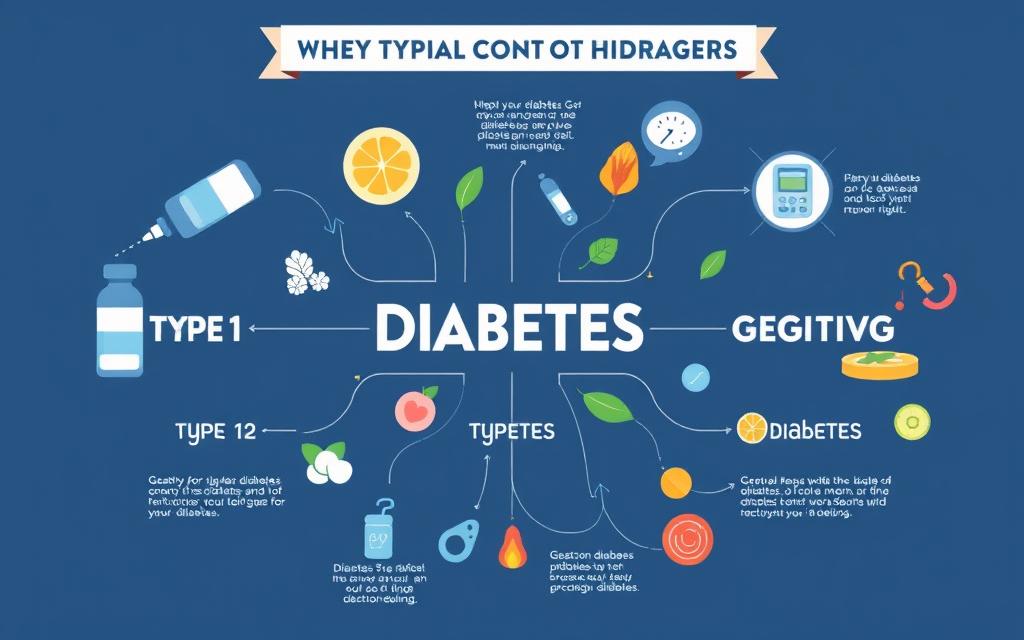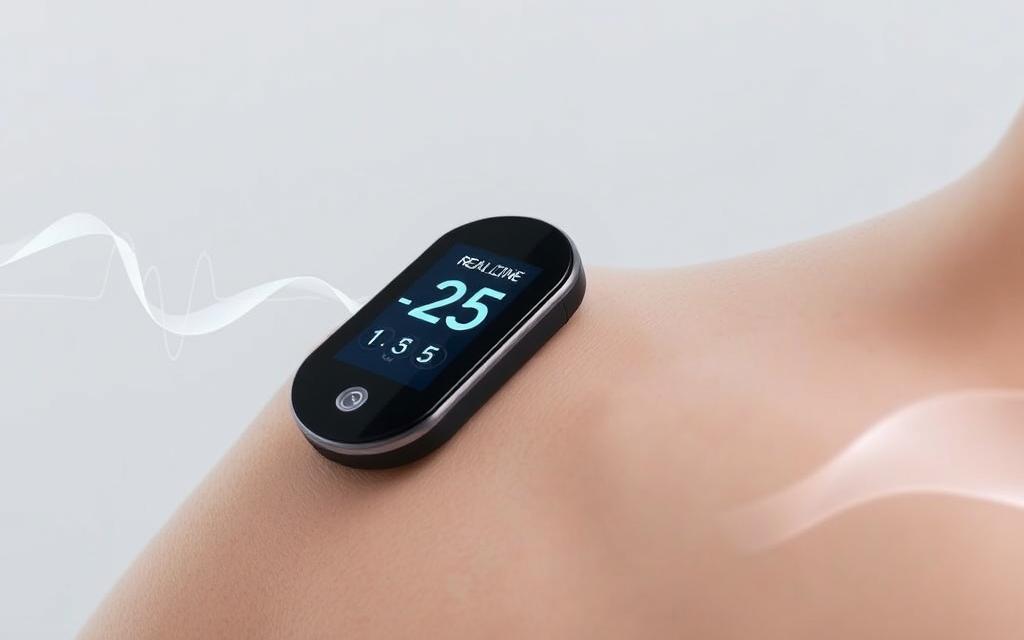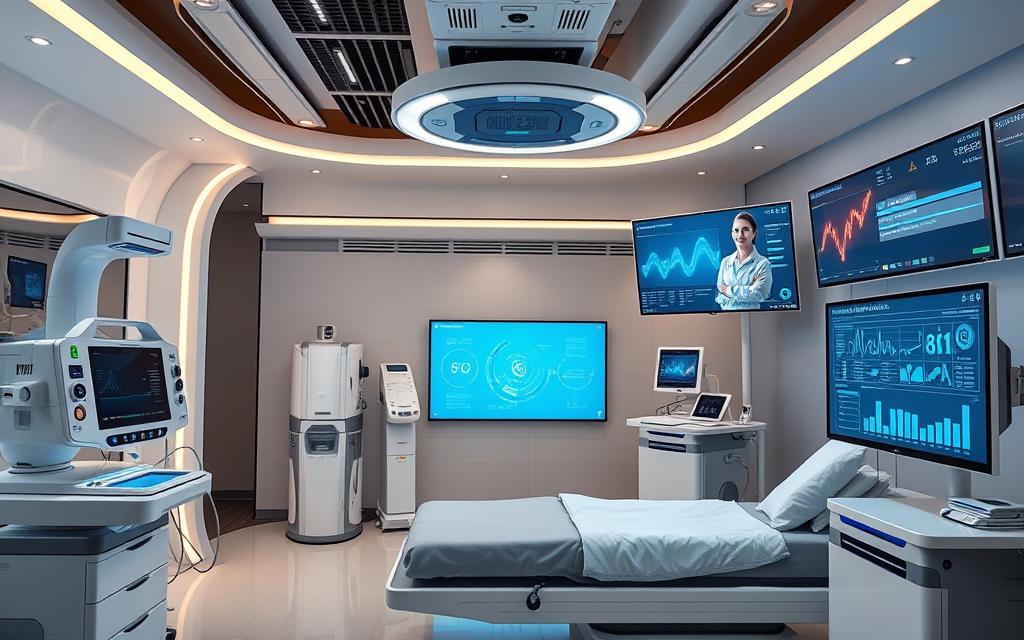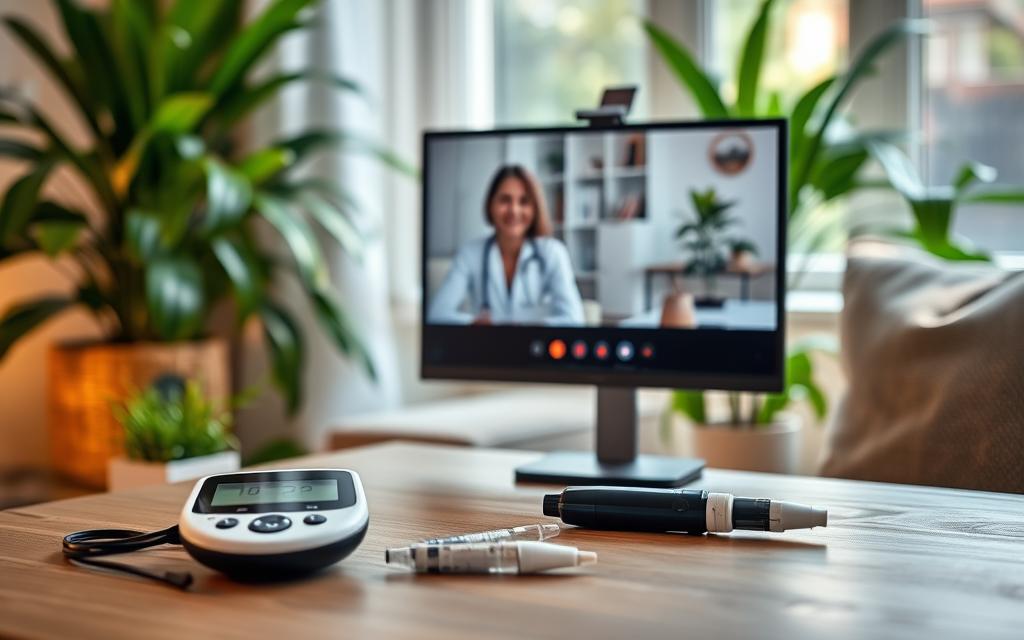Living with chronic conditions can be tough. Diabetes affects about 34.2 million Americans, or 10.5% of the U.S. population1. But, new technologies and treatments are changing lives. They’re making managing diabetes easier and improving health.
New tools like continuous glucose monitors and telehealth services are key. They help people with diabetes live better lives. These advancements are making a big difference in health outcomes.
Despite progress, challenges persist. Only about half of those with diabetes reach their blood sugar goals2. We need more support and better technology. As we look at new innovations, we see a brighter future for diabetes care.
Key Takeaways
- The innovations in diabetes care can significantly improve the daily management of the disease.
- Approximately 500 million people are affected by diabetes globally.
- Continuous Glucose Monitors (CGMs) play a vital role in blood glucose control.
- Telehealth has demonstrated effectiveness in managing diabetes through remote consultations.
- Collaborative care models are essential for reducing hospitalizations and improving patient outcomes.
- New mobile applications are enhancing patient engagement and management of diabetes.
- The evolving landscape of diabetes care technology provides hope for better health outcomes.
The Current Diabetes Landscape
We are in a critical time for diabetes, with 537 million people worldwide affected in 2021. This number is expected to hit 580 million by 20303. In the U.S., about 37 million people, or 10.5% of the population, have diabetes. This number is set to rise to 14% by 20303.
Diabetes has led to huge healthcare costs, reaching around $327 billion a year4. It’s linked to about 6.7 million deaths globally in 2021, making effective management urgent4.
The healthcare world is working hard to use new diabetes technology. We need everyone to work together to improve care and education. New tools like continuous glucose monitoring are key to better control and fewer complications3.
We must tackle the diabetes crisis head-on. It’s not just about numbers; it’s about the lives touched. As diabetes numbers grow, we aim for innovative solutions and care that puts patients first.
Understanding Diabetes and Its Types
Diabetes is a complex health condition affecting millions of Americans. As of 2019, about 37.3 million people, or 11.3% of the U.S. population, had diabetes5. Type 2 diabetes makes up about 90% to 95% of all cases6. It happens when the body’s cells don’t respond well to insulin, causing blood sugar levels to rise.
Type 1 diabetes is an autoimmune disorder where the body doesn’t make insulin. It makes up 5% to 10% of diabetes cases6. Knowing the difference is key, as nearly 25% of adults with diabetes don’t know they have it5. Also, about 96 million adults in the U.S., or 38% of the adult population, have prediabetes6. More than 80% of these people don’t know they have it.
Prediabetes is a warning sign, as it raises the risk of type 2 diabetes and heart disease5. Understanding diabetes types is vital for managing and preventing it. Knowing about type 1, type 2, and prediabetes helps healthcare providers and patients create better plans. This improves health outcomes and reduces healthcare costs.

Telehealth in Diabetes Management
Telehealth is changing how we manage diabetes. It makes it easier for people to get care from home. This means better access to doctors and tracking blood sugar levels without going to the doctor’s office.
Benefits of Telehealth for Individuals with Diabetes
Telehealth offers many benefits for diabetes care. Studies show it can lower blood sugar levels by 0.6% on average7. It also helps prevent heart problems by improving blood sugar control7.
People with type 2 diabetes see big improvements with lifestyle changes. A program showed a 2.2% drop in blood sugar levels after six months8.
Barriers to Telehealth Adoption
But, there are challenges to using telehealth for diabetes. Things like technology issues, doctor doubts, and security worries slow it down. People with less money or from certain groups use it less7.
The American Diabetes Association says telemedicine is helpful but needs to work with in-person visits for best results7. We need to solve these problems to make telehealth a big part of diabetes care.
The Role of Continuous Glucose Monitoring (CGM)
In recent years, continuous glucose monitoring has changed how people with diabetes manage their blood sugar. These devices give real-time insights into glucose levels. This has a big impact on both clinical outcomes and daily life. The latest in CGM technology lets us track glucose levels more accurately, making diabetes technology more effective.
Advancements in CGM Technology
Continuous glucose monitors can check glucose levels every few minutes. This lets users stay informed about their blood sugar levels all day9. The sensors need to be replaced every 7 to 14 days. Some implantable sensors can last up to 180 days9.
CGMs are designed to be easy to use. Some models are even safe for children as young as 2 years old9. They can send real-time glucose data to smartphones or dedicated receivers. This makes it easy for users to get the information they need9.
Patient Experiences with CGM Devices
Many people using CGMs say they have fewer low blood glucose emergencies than those with traditional glucose meters9. Studies show that using CGMs leads to better blood sugar control. This is key to preventing diabetes-related complications10.
These devices also make it less uncomfortable to check blood sugar levels often9. As technology improves, researchers aim to make CGMs even better. They want to improve sensitivity, reliability, and comfort9.

| CGM Device | Wearing Time | Calibration Frequency | Real-Time Data |
|---|---|---|---|
| Dexcom G7 | Up to 10 days | None | Yes |
| FreeStyle Libre 3 | Up to 14 days | None | Yes |
| Medtronic Guardian | Up to 7 days | Every 12 hours | Yes |
| GlucoWatch Biographer | 10-minute intervals | Every 2 hours | Partial |
Exploring the role of continuous glucose monitoring shows these devices are a game-changer. They help us manage diabetes better. Real-time tracking and patient engagement lead to better health outcomes in the long run9.
Insulin Delivery Innovations
Diabetes management technology is changing fast, thanks to new insulin delivery systems. These include advanced insulin pumps and automated systems. They are making treatment more effective for people with diabetes.
New Insulin Pumps and Automated Systems
The bionic pancreas is a big step forward in insulin delivery. In a study, it helped 326 people with type 1 diabetes lower their blood sugar levels. Their blood sugar stayed in a healthy range more often than usual11.
The Insulet SmartAdjust technology is also making a difference. It helps adults with type 2 diabetes control their blood sugar better. A study showed it worked well for many people12.
Smart Insulin Pens and Their Benefits
Smart insulin pens are a big improvement in diabetes care. They help users figure out the right amount of insulin to take. This makes it easier to follow treatment plans and feel more in control of diabetes.
Using these pens with continuous glucose monitors (CGMs) can lead to even better results. Studies show that CGMs can lower blood sugar levels by 1% over 12 months13. Together, they help people manage their diabetes more effectively.
Artificial Intelligence Applications in Diabetes Care
Artificial intelligence (AI) and predictive analytics are changing diabetes care. They offer tools for analyzing data. This leads to better health outcomes and personalized treatment plans for patients.
Healthcare professionals use big data to make better decisions. This improves patient care overall.
Data Analysis for Improved Blood Sugar Control
AI-driven data analysis is key for better blood sugar control. A study by Mohsen et al. looked at 40 studies on AI in diabetes risk prediction. Only 5 studies talked about model calibration and validation14.
Among these, 30 studies used single AI models, and 10 used multiple models. One model predicted type 2 diabetes with 96% accuracy14. This shows how using all data can improve diabetes care.
Having lots of diverse data is important. It helps make these models more accurate and fair.
Predictive Analytics Benefits
Predictive analytics brings big benefits to diabetes care. AI helps find complex patterns in diabetes data. This improves how doctors make decisions15.
Diabetes is becoming more common, and it costs a lot. We need better care models15. AI can help save money and improve health outcomes.
AI is also getting better at monitoring glucose levels in real-time. This could prevent serious problems16.

Incorporating Digital Health Data into EHRs
Adding digital health data to electronic health records (EHRs) is changing diabetes care for the better. Laws like the American Recovery and Reinvestment Act pushed for EHR adoption by January 1, 2014. This move is making health systems work better together17.
With real-time health data, doctors can plan care better. This leads to more involved patients18.
Benefits of Enhanced Interoperability
Being able to share health info easily is key. It lets doctors give treatments that fit each patient’s needs. Yet, only about 50% of people with diabetes meet treatment goals18.
Using EHRs and digital data helps doctors keep track of health issues better.
Impact on Patient Care Coordination
Good care coordination needs all health data. But, more research is needed to see how EHRs really help17. Programs like the Montana Diabetes Program show digital tools can help more people manage diabetes18.
As tech grows in diabetes care, our work to improve patient care will shape healthcare’s future.
Emerging Models of Care During COVID-19
The COVID-19 pandemic has changed how we treat diabetes. Telemedicine has become key, letting patients see doctors safely. It helps stop the virus from spreading. About 500 million people worldwide have diabetes, but only half control their blood sugar well19.
Adaptations in Diabetes Treatment
During the pandemic, we had to change how we treat diabetes. Doctors started using telemedicine to care for patients without risking their health. About 71% of people hospitalized with COVID-19 had diabetes or other health issues20.
New ways to manage diabetes came up. These helped us keep an eye on patients and treat them from a distance.
Telemedicine Success Stories
Telemedicine has led to better health outcomes. The Endocrine Society has shown how telehealth improved diabetes care during the pandemic19. Virtual visits helped patients stick to their treatment plans and manage their diabetes better.
But, we also know we need some in-person care. This is mainly for high-risk diabetes patients. It ensures they get the care they need, even when doctors are short-staffed20.

Collaborative Care Models in Diabetes
In the world of diabetes care, teamwork is key. We bring together doctors, pharmacists, dieticians, and diabetes educators. This team effort helps patients get better care and improves our way of managing diabetes.
Team-Based Approaches to Management
Team-based diabetes care is showing great results. Studies show it can lower blood sugar levels by about 0.5%21. People in these teams stick to their meds better and manage their diabetes more effectively.
But, not all patients get the education they need right away. About 5-10% miss out on diabetes education in their first year21. That’s why working together is so important. It makes sure more patients get the help they need.
Pharmacist Integrations in Diabetes Care
Pharmacists are a big part of these teams. They help manage medications, making care better and patients happier. Research shows teams with pharmacists do better in lowering blood sugar and hospital visits22.
Pharmacists do more than just meds. They teach patients how to manage their diabetes. This teamwork leads to better blood sugar control and health outcomes. It shows how crucial pharmacists are in diabetes care.
| Collaborative Care Outcomes | A1C Reduction (%) | Patient Satisfaction (%) | Cost Comparison |
|---|---|---|---|
| Traditional Care | 0.0 | Variable | Higher Healthcare Costs |
| Collaborative Care | 0.5 | High Satisfaction | Comparable |
Addressing Diabetic Complications with New Technology
Recently, technology has made big strides in fighting diabetic complications. This includes better care for diabetic feet and monitoring heart health. It’s crucial to find ways to help those with diabetes, as about one in ten Americans have it23. With so many people at risk, new solutions are more vital than ever.
Technological Interventions for Diabetic Foot Care
Technology for diabetic foot care has really improved. Now, there are automated systems that watch for problems early. These systems can warn both patients and doctors about issues like ulcers. Using these tools can lead to healthier feet and save money on healthcare24.
Monitoring for Retinopathy and Cardiovascular Health
New imaging tech helps spot retinopathy early. This is a big win for managing diabetes. Also, tech for watching heart health gives doctors key info for acting fast. These tools help patients do better and stay healthy23.
| Technology | Purpose | Impact on Diabetic Complications |
|---|---|---|
| Automated Foot Monitoring Systems | Alerting for potential foot issues | Reduces risk of ulcers and amputations |
| Advanced Retinal Imaging | Early detection of retinopathy | Improves management and outcomes |
| CVD Monitoring Devices | Track cardiovascular health | Enables early intervention for heart health |
By using these new technologies, we can fight diabetes better. This means a better life for millions of people with diabetes.
Future Prospects for Diabetes Treatments
We are on the brink of big changes in diabetes treatments. New therapies are being developed, which could change how we manage diabetes. By 2050, over 1.31 billion people might have diabetes worldwide25. This shows how urgent it is to find effective treatments.
Type 2 diabetes, which makes up 90% of cases, is expected to grow due to lifestyle choices26.
Innovative Drug Therapies on the Horizon
In 2023, the FDA approved new insulin biosimilars like Admelog, making treatment more affordable25. Teplizumab was also approved, marking a big step in treating type 1 diabetes25. Evotec is working on a stem cell therapy for type 1 diabetes, showing promise for the future27.
Potential Breakthroughs in Type 1 and Type 2 Diabetes Care
New advancements in diabetes care are coming. Automated insulin systems and artificial pancreas technology could improve glucose control for type 1 diabetes27. Research on β-cell regeneration and immunotherapy could lead to new treatments for diabetes25.
Studies show the power of personalized and automated diabetes management26. The use of advanced technology in diabetes treatments is a big step forward. With diabetes expected to affect 783 million by 2045, finding new treatments is more important than ever27.
Diabetes Registries and Their Importance
Diabetes registries are key in the battle against diabetes. They help us collect and analyze data on how well patients are doing. This data gives us insights into how to manage and treat diabetes better.
There are 12 national clinical diabetes registries worldwide. Over 7 million diabetic patients are registered on these platforms28. The data collected, like weights and HbA1c levels, helps us track health outcomes28.
Utilizing Data for Research and Treatment Improvements
Researchers use data from diabetes registries to improve treatments. Almost all registries track important health outcomes. This lets us compare results with international standards28.
In places like the Rio Grande Valley, local registries are crucial. They aim to tackle diabetes with programs like Surveillance, Intervention, Research, and Education (SIRE)29.
Impact on Healthcare Policy and Funding
The data from registries also shapes healthcare policy and funding. It helps policymakers understand community needs and allocate resources wisely28. For example, more countries are setting up diabetes registries, showing growing awareness of the issue28.
As diabetes costs rise, funding for research becomes more critical. This ensures we develop the best care plans for the future28.
Security in Diabetes Technology
Advanced diabetes technologies are becoming more common. But, we must not forget the importance of keeping these devices secure. Cybersecurity is key to protecting patient data, as more devices connect to the internet. This ensures we can trust the technology we use.
Cybersecurity Concerns with Diabetes Devices
Connected diabetes devices, like Continuous Glucose Monitors (CGMs), need strong security. The DTSEC standard requires these devices to have secure software and communication channels30. Bluetooth Low Energy (BLE) technology is used in these devices, offering efficiency and connectivity31.
BLE can connect to many devices, but in practice, it usually connects to just a few to ten31. Also, BLE’s use in medical devices has raised concerns about vulnerabilities. There are known issues that could let unauthorized access to communications30.
Best Practices for Protecting Patient Data
To reduce risks, it’s vital to focus on cybersecurity during device design. We suggest regular security checks, including vulnerability analysis and penetration testing. Device makers should also create detailed Security Target (ST) documents to show they meet security standards30.
Following HIPAA regulations is also crucial to keep patient data safe and private30. Teaching patients about data privacy helps them protect their information. This way, they can enjoy the benefits of technology while managing their diabetes.
Conclusion
Diabetes management is changing thanks to new technology and care methods. Over 400 million adults have diabetes, and type 2 makes up most cases32. New tools like continuous glucose monitoring and telehealth help us manage it better.
These tools help us catch problems early and work together as a team. This teamwork is key to better care for people with diabetes.
Diabetes can also harm your eyes, and many people don’t get checked often enough33. It’s crucial for doctors and eye care teams to talk more. This way, we can catch eye problems early and treat them well.
With more people getting diabetes, we need better ways to manage it34. We must keep learning, researching, and using new technology. This will help us give better care to those with diabetes.
Working together and using new tech is the way forward. It will help us improve health for everyone, now and in the future33.
FAQ
What are the main types of diabetes?
There are three main types of diabetes. Type 1 diabetes is an autoimmune condition. Type 2 diabetes is caused by insulin resistance. Prediabetes is a stage before Type 2 diabetes.
How can telehealth benefit individuals with diabetes?
Telehealth offers more access to specialists. It helps monitor blood sugar levels better. It also makes managing diabetes easier without needing to see a doctor in person.
What are continuous glucose monitors (CGMs) and their advantages?
CGMs, like the Dexcom G7 and FreeStyle Libre 3, track blood sugar levels in real-time. They don’t need fingersticks. This helps patients control their blood sugar better with the data they get.
How have insulin delivery systems improved?
New systems, like the t:slim X2 insulin pump, adjust insulin based on blood sugar levels. Smart pens, like the InPen, do the same. These advancements make treatment more effective.
What role does artificial intelligence play in diabetes care?
Artificial intelligence helps manage diabetes by analyzing patient data. It improves decision-making and helps control blood sugar levels better.
How does integrating digital health data into electronic health records (EHRs) enhance diabetes care?
Adding diabetes data to EHRs helps healthcare providers make better decisions. It leads to more personalized care and better patient involvement.
What adaptations in diabetes care have emerged during the COVID-19 pandemic?
The pandemic made telemedicine and eConsults more common. This improved access to specialists while keeping patients safe. It has led to better health outcomes and patient satisfaction.
How does a collaborative care model improve diabetes management?
Working together with healthcare teams, like pharmacists and dieticians, leads to better results. Patients see improved blood sugar levels and stick to their treatment plans better.
What innovative technologies help address diabetic complications?
New technologies, like automated foot care systems and advanced eye scans, help catch and manage complications early. This reduces healthcare costs.
What are the future prospects for diabetes treatments?
Future treatments might include new drugs that target insulin resistance and protect beta cells. This could lead to better management of both Type 1 and Type 2 diabetes.
How important are diabetes registries for research?
Diabetes registries are key for collecting data to improve treatments and understand the disease. They help policymakers make better decisions about healthcare resources.
What are the cybersecurity concerns related to diabetes technology?
As diabetes technology grows, so do concerns about keeping patient data safe. Protecting this data is crucial to keep patients trusting in digital health solutions.
What best practices can be followed to protect patient data in diabetes technology?
To keep patient data safe, use strong cybersecurity, update systems regularly, and teach patients about data privacy. This ensures their information is protected.
Source Links
- Six Digital Health Technologies That Will Transform Diabetes – https://pmc.ncbi.nlm.nih.gov/articles/PMC9846384/
- Innovations in Diabetes Care for a Better “New Normal” Beyond COVID-19 – https://pmc.ncbi.nlm.nih.gov/articles/PMC7665547/
- From screening to treatment: the new landscape of diabetic kidney disease – BMC Medicine – https://bmcmedicine.biomedcentral.com/articles/10.1186/s12916-022-02537-4
- Advances in the management of type 2 diabetes in adults – https://bmjmedicine.bmj.com/content/2/1/e000372
- What Is Diabetes? – NIDDK – https://www.niddk.nih.gov/health-information/diabetes/overview/what-is-diabetes
- Diabetes Basics – https://www.cdc.gov/diabetes/about/index.html
- Telemedicine in Diabetes Care – https://www.aafp.org/pubs/afp/issues/2022/0300/p281.html
- Role of Telemedicine in Diabetes Management – https://pmc.ncbi.nlm.nih.gov/articles/PMC10210114/
- Continuous Glucose Monitoring – NIDDK – https://www.niddk.nih.gov/health-information/diabetes/overview/managing-diabetes/continuous-glucose-monitoring
- Role of continuous glucose monitoring in diabetes management – https://www.elsevier.es/es-revista-avances-diabetologia-326-articulo-role-continuous-glucose-monitoring-in-S1134323010620029
- Bionic pancreas improves type 1 diabetes management compared to standard insulin delivery methods – https://www.nih.gov/news-events/news-releases/bionic-pancreas-improves-type-1-diabetes-management-compared-standard-insulin-delivery-methods
- FDA Clears First Device to Enable Automated Insulin Dosing for Individuals with Type 2 Diabetes – https://www.fda.gov/news-events/press-announcements/fda-clears-first-device-enable-automated-insulin-dosing-individuals-type-2-diabetes
- Breakthrough Studies on Automated Insulin Delivery and CGM for Type 2 Diabetes Unveiled at ADA Scientific Sessions – https://diabetes.org/newsroom/press-releases/breakthrough-studies-automated-insulin-delivery-and-cgm-type-2-diabetes
- AI-based diabetes care: risk prediction models and implementation concerns – npj Digital Medicine – https://www.nature.com/articles/s41746-024-01034-7
- Artificial intelligence in diabetes management: Advancements, opportunities, and challenges – https://pmc.ncbi.nlm.nih.gov/articles/PMC10591058/
- Artificial Intelligence/Machine Learning in Diabetes Care – https://pmc.ncbi.nlm.nih.gov/articles/PMC6844177/
- Diabetes Care and Management Using Electronic Medical Records: A Systematic Review – https://pmc.ncbi.nlm.nih.gov/articles/PMC6610600/
- Frontiers | The critical elements of digital health in diabetes and cardiometabolic care – https://www.frontiersin.org/journals/endocrinology/articles/10.3389/fendo.2024.1469471/full
- COVID-19 pandemic drives innovation in diabetes care – https://www.endocrine.org/news-and-advocacy/news-room/2020/covid19-pandemic-drives-innovation-in-diabetes-care
- ENDOCRINOLOGY IN THE TIME OF COVID-19: Remodelling diabetes services and emerging innovation – https://pmc.ncbi.nlm.nih.gov/articles/PMC7938018/
- Collaborative Care for Patients with Diabetes – Blog – NIDDK – https://www.niddk.nih.gov/health-information/professionals/diabetes-discoveries-practice/collaborative-care
- Collaborative care model for diabetes in primary care settings in Qatar: a qualitative exploration among healthcare professionals and patients who experienced the service – BMC Health Services Research – https://bmchealthservres.biomedcentral.com/articles/10.1186/s12913-021-06183-z
- Diabetes technology: the future is today, UAB expert says – https://www.uab.edu/reporter/patient-care/advances/item/10135-diabetes-technology-the-future-is-today
- The Use of Diabetes Technology to Address Inequity in Health Outcomes: Limitations and Opportunities – https://pmc.ncbi.nlm.nih.gov/articles/PMC9157044/
- Trailblazing Discoveries: The Top 5 Diabetes Research Breakthroughs of 2023 – https://www.news-medical.net/health/Trailblazing-Discoveries-The-Top-5-Diabetes-Research-Breakthroughs-of-2023.aspx
- Diabetes treatment in 2025: can scientific advances keep pace with prevalence? – https://pmc.ncbi.nlm.nih.gov/articles/PMC3498849/
- The future of diabetes treatment: Is a cure possible? – https://www.labiotech.eu/in-depth/diabetes-treatment-cure-review/
- National diabetes registries: do they make a difference? – https://pmc.ncbi.nlm.nih.gov/articles/PMC7907019/
- Diabetes Registry | UTRGV – https://www.utrgv.edu/bho/diabetes-registry/index.htm
- Assessing the Security of Connected Diabetes Devices – https://pmc.ncbi.nlm.nih.gov/articles/PMC5478036/
- Bluetooth Wireless Technology Cybersecurity and Diabetes Technology Devices – https://pmc.ncbi.nlm.nih.gov/articles/PMC7645127/
- Diabetes, its causes, its symptoms and conclusion – https://www.thcjbp.com/blog/diabetes-its-causes-its-symptoms-and-conclusion
- Summary and Conclusion – A Practical Guide to Diabetes-Related Eye Care – https://www.ncbi.nlm.nih.gov/books/NBK582430/
- The prevention and control the type-2 diabetes by changing lifestyle and dietary pattern – https://pmc.ncbi.nlm.nih.gov/articles/PMC3977406/
